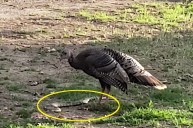While it is not uncommon for your home to smell like food if you are whipping up something in the kitchen, certain food smells can signify potential danger. These three common food smells can indicate that there is a snake in your home. In this article, we will share with you how to smell a snake hiding in your home.
Smell A Snake Hiding In Your Home

Photo by Dan Kitwood/Getty Images
If you have ever heard the expression, "Trust your gut," we will add one more. "Trust your nose" is the new phrase! While you trust your nose to tell if your food has spoiled or if you like what your mom is cooking on the stove, you should also trust your nose to alert you to potential danger.
Not only can you smell smoke or gasoline and recognize that a fire may happen, but your nose can also help you smell a snake hiding in your home. Below are three familiar food smells that might indicate a sneaky serpent in your home.
1. Cucumbers

Pexels: Karolina Kaboompics
Smelling it is no big deal if you are actively cutting up a cucumber for a salad or some refreshing spa water. However, if you are not actively cooking with this produce and you smell it, look out. Total Reptile shares that the cucumber-like odor is a specific smell that is associated with rattlesnakes and copperheads. They state:
"Rattlesnakes are known to be one of the more strongly smelling snakes. Their dens have been reported to smell like cucumbers and this is believed to be because of a hiberantion odour which is released by the rattlensake."
They go on to explain that the musky smell that surrounds the copperhead snake also resembles a cucumber-like smell. While some people argue that the copperhead releases this smell when they are touched or threatened, scientists disagree. Scientists believe it is more likely that the copperhead has this smell because of the plants that it comes into contact with in its natural habitat.
If you smell this odor, look for snakes in attics, basements, or garages. Taste of Country shares how those are common places where snakes like to curl up and hide.
2. Fish

Pexels: mali maeder
With this smell, we are not talking about that slight odor of making baked salmon. Instead, this odor would be a lingering fishy smell that does not seem to dissipate. Certain snakes give off a fishy-smell odor with their musk. Some snakes known to release this odor are watersnakes, sea snakes, and garter snakes.
The Florida Museum shares how the Southern Waternsake acts when it is threatened. This snake will "flatten their head and body, bite the attacker, and release a foul-smelling musk from a pair of glands in the base of their tail." While this snake is not venomous, you still want to avoid a bite.
Garter snakes have the same foul-smelling musk and release it when threatened. Nature Detectives elaborate further by sharing that their musk doesn't only smell bad, but it tastes bad, too. This helps the snake fend off potential predators, and now it can help you smell a snake hiding in your home.
3. Rotten Eggs

Pexels: Pixabay
While this smell never means something good, it typically clues someone in on a gas leak in their home. However, although less common, there is another potential source of the smell. A rotten egg smell can mean that you are smelling a snake hiding in your home. SnakeSnuggles shares that "snakes release urine, rotten egg, or sulfur-like odors as a defense mechanism when threatened."
In addition to releasing these odors when threatened, snakes also use odors to communicate with one another. For example, they use their odor to mark territory, attract mates, or fend off predators. Some snakes known to have this "rotten-egg" musk odor are rat snakes, rattlesnakes, and cottonmouths.
While the black rat snake tends to avoid contact with humans, it can be found near trash dumps, abandoned buildings, or barns. If it is harassed by unsuspecting homeowners or landowners, it releases a foul-smelling odor.
Other Signs of Snakes

Shutterstock / MArc Freebrey
Besides smelling a snake hiding in your house, there are other key signs that this reptile may be dwelling in your home. Cinch Home Services lists the following as signs that you may have a snake in your home.
- Finding shredded snake skin
- Slither tracks on dirty or dusty surfaces.
- Unexpected noises coming from flooring areas (i.e., in a crawl space or things falling over)
- Snake droppings
- Sudden disappearance of rodents
Snake Types, Hiding Spots, And More

Photo by David McNew/Getty Images
While the type of snake that is most common depends on the area in which you live, some snakes tend to frequent homes more often than most. Rat snakes are frequently found in homes, especially if there is a rodent problem. Other snakes, like the Cottonmouth, may not frequent inside the home often but can be found in your garden.
Critter Control shares the most common places where snakes are found: in people's homes.
- Behind the refrigerator
- Under the oven
- Under your bed
- Inside cabinets
- Crawl spaces
- Basements
- Garages
- Attics
If you want to keep snakes out of your home, seal up any gaps in your building, clear debris from your yard regularly, maintain landscaping, and control rodent populations.




